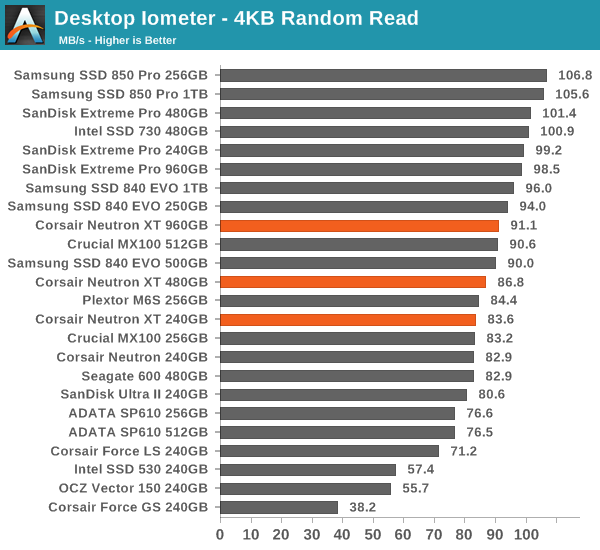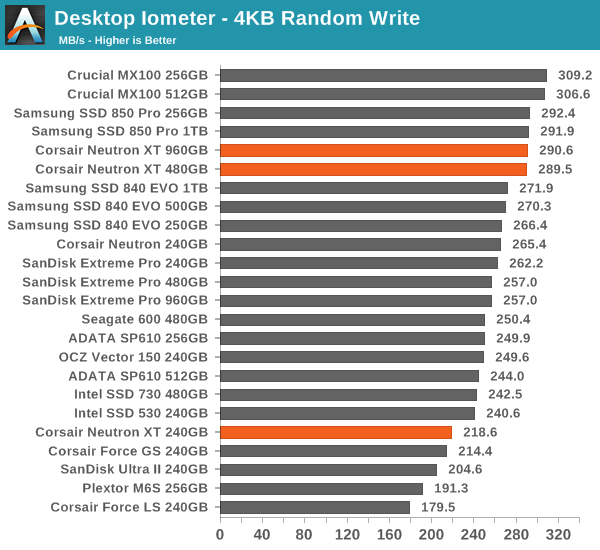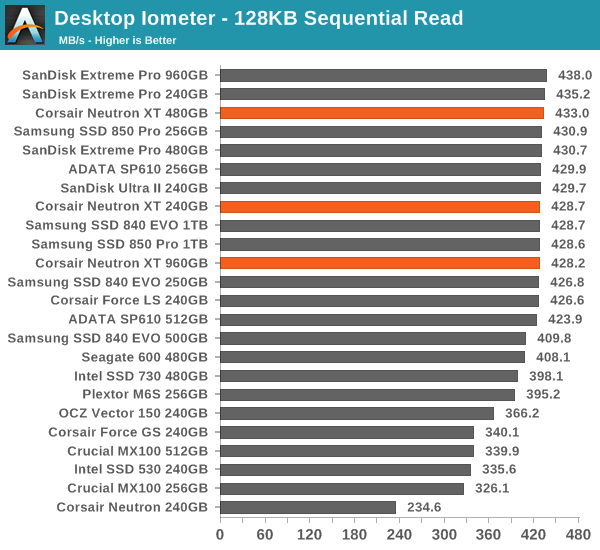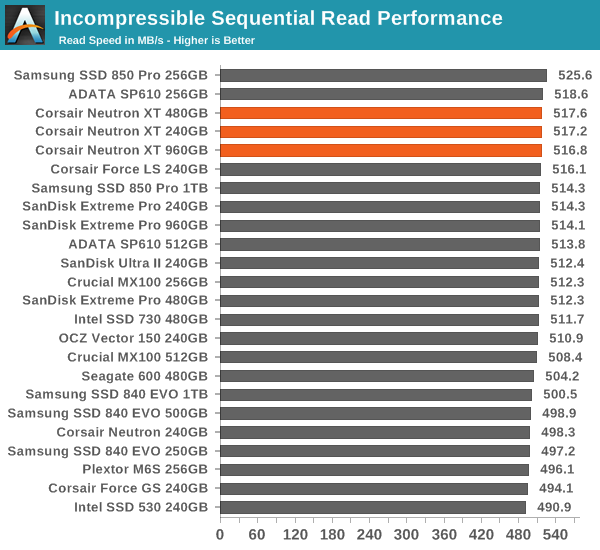Corsair Neutron XT (240GB, 480GB & 960GB) SSD Review: Phison S10 Debuts
by Kristian Vättö on November 17, 2014 9:00 AM ESTRandom Read/Write Speed
The four corners of SSD performance are as follows: random read, random write, sequential read and sequential write speed. Random accesses are generally small in size, while sequential accesses tend to be larger and thus we have the four Iometer tests we use in all of our reviews.
Our first test writes 4KB in a completely random pattern over an 8GB space of the drive to simulate the sort of random access that you'd see on an OS drive (even this is more stressful than a normal desktop user would see). We perform three concurrent IOs and run the test for 3 minutes. The results reported are in average MB/s over the entire time.

Random read speed gets a boost compared to the Force LS and the Phison finally appears to be on-par with the others.


Random write speed is also good, although the 240GB model could perform better at lower queue depths.
Sequential Read/Write Speed
To measure sequential performance we run a 1 minute long 128KB sequential test over the entire span of the drive at a queue depth of 1. The results reported are in average MB/s over the entire test length.

Here we see the performance drop when the capacity increases again. The 960GB model is quite noticeably slower in write speed compared to the rest of the capacities, although at 355MB/s it definitely isn't slow.

AS-SSD Incompressible Sequential Read/Write Performance
The AS-SSD sequential benchmark uses incompressible data for all of its transfers. The result is a pretty big reduction in sequential write speed on SandForce based controllers, but most other controllers are unaffected.












56 Comments
View All Comments
SanX - Monday, November 17, 2014 - link
One more average drive. Speeds need to double or price drop to double for that stuff to be interesting again.hojnikb - Monday, November 17, 2014 - link
Yup. If this ends up being priced closer to 850pro, it wont make any sense whatsoever.hojnikb - Monday, November 17, 2014 - link
Any reason why they are using 64Gbit flash on 480GB aswell ?at 512GB raw flash, it should be enough to saturate controller with 128Gbit dies (thats 32 dies).
SleepyFE - Monday, November 17, 2014 - link
How did you count 32 dies? 4x128=512, that's 4 dies. With 8 dies (8x64) you fill all eight channels. Better parallelism. That's how i understand it.Mikemk - Monday, November 17, 2014 - link
4*128Gbit = 4*16GB = 64GB32*128Gbit = 32*16GB=512GB
hojnikb - Tuesday, November 18, 2014 - link
Its in Gigabits, not gigabytes. Single die is 128Gbit (so 16GB) so you need 32 of them to get 512GB.SleepyFE - Tuesday, November 18, 2014 - link
Sorry about that. So used to gigabytes. Aren't the dies stacked to make 64GB packages and then a single bus leads to that bundle?makerofthegames - Monday, November 17, 2014 - link
tl;dr it's not a bad drive, but it's not good in any particular niche. If it's not cheaper than the dozens of similarly good-enough drives out there, it's a dead product.beginner99 - Monday, November 17, 2014 - link
Exactly. And given the crucial mx100 pricing and performance which should suit almost any consumer and enthusiast it's hard to come up for any reason to buy this unless it is cheaper (highly doubt that). And if you really need ultimate performance you will go Sandisk or 950 pro (or intel pcie).Mikemk - Monday, November 17, 2014 - link
850 pro?